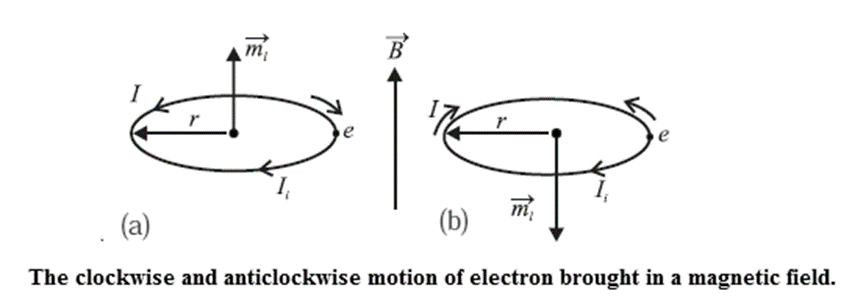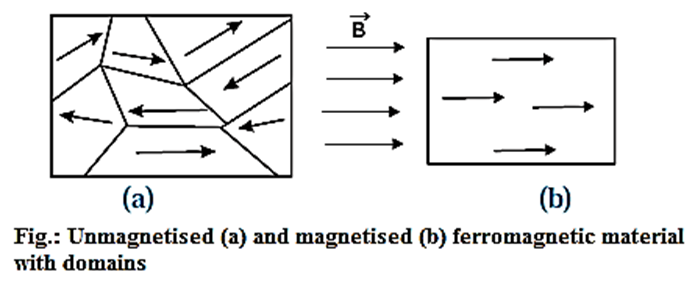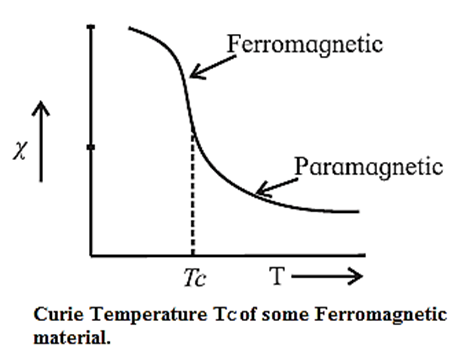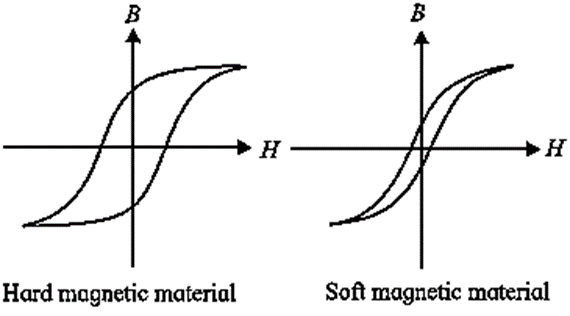Magnetic Materials
Maharashtra Board-Class-12th-Physics-Chapter-11
Notes-Part-2
Topics to be Learn : Part-2
|
Magnetic Properties of Materials:
Materials are widely categorised as diamagnetic, paramagnetic, and ferromagnetic based on how they behave in the presence of an external magnetic field.
Magnetic susceptibility for diamagnetic material is negative and for paramagnetic positive but small. For ferromagnetic materials it is positive and large.
Range of magnetic susceptibility of diamagnetic, paramagnetic and ferromagnetic materials :
| Types of material | χ |
| Diamagnetic | −10−3 − −10−5 |
| Paramagnetic | 0 − 103 |
| Ferromagnetic | 102 − 103 |
Diamagnetism:
Atoms/molecules with completely filled electron orbit possess no net magnetic dipole moment. Such materials behave as diamagnetic materials.
Diamagnetic material : A material which is weakly repelled by a magnet and whose atoms/molecules do not possess a net magnetic moment in the absence of an external magnetic field is called a diamagnetic material.
Diamagnetism : When a diamagnetic material is placed in a uniform magnetic field, it acquires a small net induced magnetic moment directed opposite to the field. The induced magnetism exhibited by such materials is called diamagnetism.
- Examples : Bismuth, copper, gold, silver, antimony, mercury, water, air, hydrogen, lead, silicon, nitrogen, sodium chloride. .
Properties of a diamagnetic material :
- The magnetic dipole moment of each atom or molecule of a diamagnetic material is zero in the absence of an external magnetic field.
- A diamagnetic material is weakly repelled by a magnet.
- In an uniform magnetic field, a thin rod of a diamagnetic material comes to rest with its length perpendicular to the field.
- When placed in a nonuniform magnetic field, a diamagnetic material is repelled from the region of strong field.
- The magnetic susceptibility (χm) of a diamagnetic material is small and negative.
- χm is very nearly temperature-independent.
- The relative permeability (μr) of a diamagnetic material is slightly less than 1 and very nearly temperature-independent.
- If a diamagnetic liquid in a watch glass is placed on two closely spaced pole-pieces of a magnet, the liquid accumulates on the sides causing a depression at the centre. When the pole-pieces are moved apart, the effect is reversed, i.e., the diamagnetic liquid accumulates at the centre, where the magnetic field is weak.
- A diamagnetic liquid in a U-tube placed in a magnetic field shows a depression in the arm to which the magnetic field is applied.
- If a diamagnetic gas is introduced between the pole-pieces of a magnet, it spreads at right angles to the field.
Origin of diamagnetism on the basis of atomic structure :
- An atomic electron is equivalent to a current loop which has orbital magnetic moment. Further, electron spin gives rise to the spin magnetic moment. The magnetic moment of an atom is equal to the vector sum of the magnetic moments of all its electrons.
- The electronic configuration in an atom of a diamagnetic material is such that the vector sum of the orbital and spin magnetic moments of all the electrons is zero. Thus, the atomic magnetic moment is zero. Hence, a diamagnetic material has no inherent magnetic moment associated with it.
- When a diamagnetic material is placed in a magnetic field, the orbiting electrons are accelerated or decelerated depending on their sense of revolution. For the electrons that are speeded up, the magnetic moment increases and for those that are slowed down, the magnetic moment decreases.
- This happens due to induced current as per Lenz's law. Thus, each atom acquires a net magnetic moment and the diamagnetic material is weakly magnetized. The induced magnetic moment is opposite in direction to the applied field.

- Diamagnetism is the weakest magnetic phenomenon. Hence, although diamagnetism is a universal property, it can be detected only in the absence ofproperties resulting in para- and ferromagnetism.
Diamagnetic behaviour of super-conductors :
When superconductors (χ = - 1) are placed in an external magnetic field, the field lines are completely expelled. There is no magnetic field inside the material, i.e., the material exhibits perfect diamagnetism. The expulsion of the magnetic field in a superconducting material is called the Meissner effect.
If a good electrical conductor is kept in a magnetic field, the field lines do penetrate the surface region to a certain extent.
Paramagnetism:
Paramagnetic material : A paramagnetic material is one that is weakly attracted by a magnet and whose atoms have a net magnetic moment, with all atomic magnetic moments randomly directed in the absence of an external magnetic field but capable of being aligned in the direction of the applied magnetic field.
- Examples : Aluminium, platinum, chromium, manganese, S0diUm/ Calcium, magnesium, lithium, tungsten, niobium, copper chloride, oxygen.
Properties of a paramagnetic material :
- Each atom of a paramagnetic material possesses a magnetic dipole moment. However, in the absence of an external magnetic field, the atomic magnetic moments are randomly oriented and hence the resultant magnetization of a paramagnetic material is zero.
- A paramagnetic material is weakly attracted by a magnet.
- If a thin rod of a paramagnetic material is suspended in a uniform magnetic field, it comes to rest with its length parallel to the field.
- When placed in a nonuniform magnetic field, a paramagnetic material is attracted towards the region of strong field.
- The magnetic susceptibility (χm) of a paramagnetic material is small and positive.
- χm varies inversely with the absolute temperature T.
- The relative permeability (μr) of a paramagnetic material is slightly greater than 1 and decreases with increasing temperature.
- If a paramagnetic liquid in a watch glass is placed on two closely spaced pole-pieces of a magnet, it shows a slight rise in the middle.
- A paramagnetic liquid in a U-tube placed in a magnetic field shows a rise in the arm to which the magnetic field is applied.
Know This :
|
Origin of paramagnetism on the basis of atomic structure :
- The presence of permanent atomic or molecular magnetic dipole moments is required for paramagnetism. The intrinsic net atomic magnetic moment is determined by the spin and orbital magnetic moments of its electrons.
- The spin magnetic moments of the electrons in matter are affected by the internal magnetic field created by the magnetic moments of surrounding electrons. This internal field, ~ 10-2 T to 10-1 T, causes the spin magnetic moments to precess about the field direction.
- At normal temperature; the thermal motion of the electrons produces constant fluctuations in the internal field so that the spin magnetic moments have random directions, Fig. (a). In the absence of an external magnetizing field, therefore, a paramagnetic material is not magnetized.

- When the applied field strength is greater than that of the internal field, the spin magnetic moments tend to align parallel to the external field direction. But the randomizing effect of thermal agitation prevents complete alignment, Fig. (b).
- Therefore, at room temperature, when a paramagnetic material is placed in a magnetic field, it is weakly magnetized in the direction of the magnetizing field.
- If the external field is very large or the temperature is very low, the magnetic dipole moments are effectively aligned parallel to the field so as to have the least magnetic potential energy and the magnetization reaches saturation, Fig. (c).
Curie’s law : The magnetization of a paramagnetic material is directly proportional to the external magnetic field and inversely proportional to the absolute temperature of the material.
If a paramagnetic material at an absolute temperature T is placed in an external magnetic field of induction the magnitude of its magnetization
Mz ∝ Bext/T, ∴ Mz = \(c\frac{B_{ext}}{T}\)
where the proportionality constant C is called the Curie constant.
Substituting Bext = μ0H in Eq. (1),
Mz = \(C\frac{μ_0H}{T}\) ….(2)
where μ0 is the permeability of free space and H is the intensity of the magnetizing field.
The magnetic susceptibility of the medium
χm = Mz/H Thus, Eq. (2) becomes
χm = \(C\frac{μ_0}{T}\)
χm ∝ 1/T
This equation show that the magnetic susceptibility of a paramagnetic material is inversely proportional to its absolute temperature.
Thus when we increase the applied magnetic field and reduce the temperature, more number of magnetic moments align themselves in the direction of magnetic field resulting in increase in Magnetization.
Q. Classify the following atoms as diamagnetic or paramagnetic.
H, O, Zn, Fe, F, Ar, He - Is it true that all substances with even number of electrons are diamagnetic?
Answer :

It can be seen that all substances with an even number of electrons are not necessarily diamagnetic.
Ferromagnetism:
Magnetic moments in ferromagnetic atoms/molecules are similar to those in paramagnetic materials. Such substances, however, have high magnetic characteristics and can form permanent magnets.
Ferromagnetic material : A material which is strongly attracted by a magnet and whose atoms possess a net magnetic moment (largely due to electron spin) which, within a certain temperature range, spontaneously line up parallel to each other by quantum mechanical exchange interaction is called a ferromagnetic material.
- Examples : Ferromagnetism can be found in metals and rare earths such as iron, cobalt, nickel, and several transition metal alloys.
Domain theory: Atoms of a ferromagnetic material possess a net magnetic moment (largely due to electron spin). Such a material is composed of a mosaic of small regions, called domains.
In each domain, the atomic magnetic moments line up parallel to each other due to the crystal structure and quantum mechanical exchange coupling, even in the absence of an external magnetic field. This is called spontaneous magnetization.
The common direction of magnetic moment is called the domain axis.
Each domain is, therefore, spontaneously magnetized to saturation and has a net intensity of magnetization.
A domain is an extremely small region (e.g., a size of about 10-6 m—10-4 m) containing a large number (1010 — 1017) of atoms. The boundary between adjacent domains with a different orientation of magnetic moment is called a domain wall.
Ferromagnetism on the basis of the domain theory :
- Atoms of a ferromagnetic material have a permanent non-zero magnetic dipole moment, arising mainly from spin magnetic moments of the electrons.
- According to the domain theory, a ferromagnetic material is composed of small regions called domains.
- A domain is an extremely small region containing a large number (something like 1015 atoms as in common iron) of atoms.
- Within each domain, the atomic magnetic moments of nearest-neighbour atoms interact strongly through exchange interaction (a quantum mechanical phenomenon) and align themselves parallel to each other even in the absence of an external magnetic field. A domain is, therefore, spontaneously magnetized to saturation.
- In an unmagnetized material, however, the directions of magnetization of the different domains are so oriented that the net magnetization is zero.
- When an external magnetic field is applied, domains try to align themselves along the direction of the applied magnetic field. The number of domains aligning in that direction increases as magnetic field is increased. This process is referred to as flipping or domain rotation. When sufficiently high magnetic field is applied, all the domains coalesce together to form a giant domain as shown in Fig. (b).
- In nonuniform magnetic field ferromagnetic material tends to move from weaker part to stronger part of the field.

- When the strong external magnetic field is completely removed, it does not set the domain boundaries back to original position and the net magnetic moment is still nonzero and ferromagnetic material is said to retain magnetization. Such materials are used in preparing permanent magnets.
Properties of a ferromagnetic material :
- A magnetic moment exists in each atom of a ferromagnetic substance. A ferromagnetic substance is made up of domains that are spontaneously magnetised to saturation. The magnetic moments of distinct domains in an unmagnetized sample are thus orientated that the sample's macroscopic magnetization is zero.
- When a ferromagnetic material is placed in a strong external magnetic field, the domains whose magnetic moments are favourably oriented relative to the external field grow in size such that the sample acquires a nonzero macroscopic magnetization.
- A ferromagnetic material retains some magnetization even after it is removed from an external magnetic field. This magnetic retentivity is the basis of the existence of permanent magnets.
- A ferromagnetic material is strongly attracted by a magnet.
- A bar magnet, suspended in a uniform magnetic field, comes to rest with its magnetic dipole moment in the direction of the external field.
- When placed in a nonuniform magnetic field, a ferromagnetic material is attracted towards the region of strong field.
- The magnetic susceptibility (χm) and relative permeability (μr) of a ferromagnetic material are very high.
Know This :
|
Effect of Temperature:
Ferromagnetism depends upon temperature. As the temperature of a ferromagnetic material is increased, the domain structure starts distorting because the exchange coupling between neighbouring moments weakens. At a certain temperature, depending upon the material, the domain structure collapses totally and the material behaves like paramagnetic material.
Curie temperature : The temperature at which a ferromagnetic material transforms into a paramagnetic substance is called Curie temperature (Tc) of that material.
The relation between the magnetic susceptibility of a material when it has acquired paramagnetic property and the temperature Tc is given by
χm = \(\frac{C}{T-T_c}\) for T > Tc
where C is the Curie constant. Figure shows the variation of magnetic susceptibility of a ferromagnetic material with temperature.
The relation χm = \(\frac{C}{T-T_c}\) is known as Curie-Weiss law.

Curie Temperature of some materials :
| Material | Tc (K) |
| Metallic cobalt | 1394 |
| Metallic iron | 1043 |
| Fe2O3 | 893 |
| Metallic nickel | 631 |
| Metallic gadolinium | 317 |
Q. Can there be a material which is nonmagnetic?
Ans. All materials are magnetic. However, only ferromagnetic can have magnetic remanance and exhibit magnetic behaviour even in the absence of an external magnetic field. Diamagnetics and paramagnetics exhibit induced magnetism, i.e., they exhibit magnetic behaviour only in the presence of an external magnetic field.
Hysteresis:
The behaviour of ferromagnetic materials when exposed to an external magnetic field is fascinating and instructive. It is nonlinear and offers information about the sample's magnetic history.
Magnetic hysteresis : Magnetic hysteresis is a phenomenon shown by ferromagnetic materials in which the magnetic flux density through a material depends on the applied magnetizing field as well as the previous state of magnetization. Due to retention of its memory of previous state of magnetization, the flux density B lags behind (does not remain in step) with magnetizing field H. This delay in the change of its magnetization M (or equivalently, B) in response to a change in H is called hysteresis.
Hysteresis can be understood through the concept of magnetic domains. Domain boundary displacements and domain rotations are not totally reversible. When the applied magnetizing field H is increased and then decreased back to its initial value, the domains do not return completely to their original configuration but retain some memory or history of their previous alignment.
Magnetic hysteresis in a ferromagnetic material.
A large scale consequence of the magnetic behaviour of a ferromagnetic under different applied magnetic fields can be observed by placing an unmagnetized rod of the material inside a solenoid.
A current through the coil establishes the magnetizing field H, which we take as the independent variable. By measuring the voltage induced in a test coil wound alongside, we can determine changes in flux Φ and hence changes in B inside the rod. B is measured in tesla while H is measured in ampere per metre. Knowing B and H, we can always compute magnetization M. It is however usual to plot B rather than M, as a function of H.
Typical B — H plot during the following operations :
- Starting with an unmagnetized rod, B = 0 and H = 0 (Point O), H is increased until it has the value corresponding to point a : Here the rod has reached its saturation magnetization and B remains constant even with further increase in H. The lower part of the curve Oa is governed by domain growth while the upper flattening part is governed by domain rotation.

- Reduce H to zero (point b) : the curve does not retrace itself, as shown by the curve ab. This irreversibility is called hysteresis It is largely due to the domain boundary movements being partially irreversible. If the current is simply switched off at this point, the rod will have a residual magnetization as indicated by the non-zero value of B, called retentivity or remanence, for H = 0. Essentially now B = u0M, i.e., the rod has acquired a permanent magnetization.
- Reverse H and increase it in magnitude until it has the value corresponding to point c : Here B is zero. The corresponding reverse magnetizing field H is called coercivity.
- Increase H in reverse direction until saturation magnetization is reached (point d).
- Reduce H to zero again (point e).
- Reverse the current once more until point a is reached again.
- The process of taking the magnetic material once through the hysteresis loop abcdefa is called hysteresis cycle.
Hysteresis loop : A magnetic hysteresis loop is a closed curve obtained by plotting the magnetic flux density B of a ferromagnetic material against the corresponding magnetizing field H when the material is taken through a complete magnetizing cycle. The area enclosed by the loop represents the hysteresis loss per unit volume in taking the material through the magnetizing cycle.
Retentivity : The residual magnetic flux density or magnetization in a magnetic material when the magnetizing field intensity is reduced to zero is called retentivity or remanence.
Coercivity: The reversed magnetizing field strength required to reduce the remanent magnetic flux density or magnetization in a magnetic material from its remanent value to zero, i.e., to demagnetize the magnetic material completely, is called coercivity.
Permanent Magnet and Electromagnet:
Soft magnetic material : A soft magnetic material, usually iron-based, has high permeability, low retentivity and low coercivity. In other words, it does not have appreciable hysteresis, i.e. its hysteresis loop is very narrow. Such a material magnetizes and demagnetizes more easily, by small external fields.
Electromagnet :
- An electromagnet is an insulated coil wrapped around a ferromagnetic core (usually a soft iron) of high permeability and low retentivity. When a current is passed through the coil—a solenoid or toroid, the ferromagnetic material magnifies the magnetic field of the coil, the magnification factor being the relative permeability of the core.
- On passing current through the solenoid, the magnetic field associated with solenoid increases thousand folds. When the current through the solenoid is switched off, the associated magnetic field effectively becomes zero.
- An electromagnet should become magnetic when a current is passed through its coil but should lose its magnetism once the current is switched off. Hence, the ferromagnetic core (usually iron-based) used for an electromagnet should have high permeability and low retentivity, i.e., it should be magnetically ‘soft’.
- Soft iron having large permeability (>1000) and small amount of retaining magnetization, is used to make electromagnets.
Applications of an electromagnet :
- Electromagnets are used in electric bells, loud speakers and circuit breakers.
- Large electromagnets are used in junkyard cranes and industrial cranes to lift iron scraps.
- Superconducting electromagnets are used in MRI and NMR machines, as well as in particle accelerators of cyclotron family.
- Electromagnets are used in data storage devices such as computer hard disks and magnetic tapes.
Permanent magnets : Permanent magnets are prepared by using a hard ferromagnetic rod such as ALNICO (an alloy of aluminium, nickel and cobalt).
When the current is switched on, magnetic field of solenoid magnetises the rod. As the hard ferromagnetic material has a property to retain the magnetization to larger extent, the material remains magnetised even after switching off the current through the solenoid.
- Hard magnetic material has high permeability, high retentivity and very high coercivity— of the orders of 1 tesla and 104 ampere per metre, respectively.
- In other words, it has a large zero-field magnetization, and large reverse field needed to demagnetize.
- Its hysteresis loop is very broad.
- Such a material can be made into a permanent magnet, that is, its magnetization will persist indefinitely if it is subsequently exposed only to weak magnetic fields.

Magnetic Shielding:
The use of a shell or box of magnetic material of high permeability to protect sensitive instruments from stray magnetic fields is called magnetic shielding.
The permeability of the material being many order of magnitudes greater than air, the magnetic field lines pass through the shell. The saturation induction B of the material must be greater than the external field to be shielded.
Figure shows the cross section of a cylindrical or spherical shield in which the central region is the field—free region.
Magnetic shielding is useful for a wide range of applications, from small components inside a set of speakers to large magnetically shielded rooms.

Know This :
|
Main Page : – Maharashtra Board Class 12th-Physics – All chapters notes, solutions, videos, test, pdf. Previous Chapter : Chapter-10-Magnetic Fields due to Electric Current –Online Notes Next Chapter :Chapter-12- Electromagnetic Inductions – Online Notes
We reply to valid query.